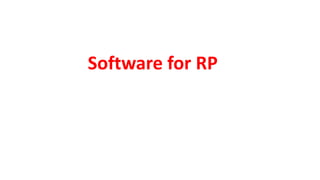Presentation1.pptx
- 2. 1. Software for RP 1. âĒ STL (Stereolithography) is a file format native to the stereolithography CAD software created by 3D Systems. STL has several after-the-fact backronyms such as "Standard Triangle Language" and "Standard Tessellation Language". 2. âĒ STL was invented by the Albert Consulting Group for 3D Systems in 1987. The format was developed for 3D Systems' first commercial 3D printers. Since its initial release, the format remained relatively unchanged for 22 years. In 2009, an update to the format, dubbed STL 2.0, was proposed. 3. âĒ This file format is supported by many other software packages; it is widely used for rapid prototyping, 3D printing and computer-aided manufacturing. 4. âĒ STL files describe only the surface geometry of a three-dimensional object without any representation of color, texture or other common CAD model attributes. The STL format specifies both ASCII and binary representations. Binary files are more common, since they are more compact. 5. âĒ An STL file describes a raw unstructured triangulated surface by the unit normal and vertices (ordered by the right-hand rule) of the triangles using a three-dimensional Cartesian coordinate system. STL coordinates must be positive numbers, there is no scale information, and the units are arbitrary. ASCII STL âĒ An ASCII STL file begins with the line âĒ Solidname where name is an optional string (though if name is omitted there must still be a space after solid). The file continues with any number of triangles, each represented as follows: âĒ facet normal ninjnk outer loop
- 3. âĒ ASCII STL âĒ âĒ An ASCII STL file begins with the line âĒ âĒ Solidname where name is an optional string (though if name is omitted there must still be a space after solid). âĒ The file continues with any number of triangles, each represented as follows: âĒ âĒ facet normal ninjnk âĒ outer loop



